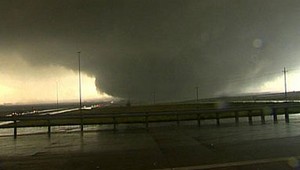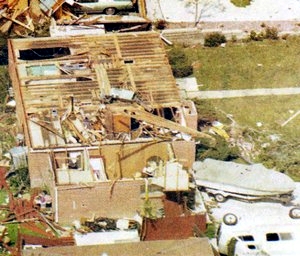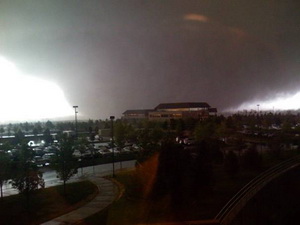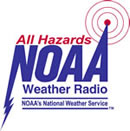
As we pointed out in our April weather preview, the month can bring just about any type of weather condition and we see that in our look back at this week in Denver weather history. From powerful, damaging winds to Arctic cold to heavy snowfall this has been an eventful week in the past.
From the National Weather Service:
31-3
In 1979…total snowfall of 6.6 inches was measured at Stapleton International Airport where north winds gusted to 31 mph on the 31st. The greatest accumulation of snow on the ground was 3 inches on the 1st.
31-4
In 1905…much rain and some snow occurred over the 5 days behind an apparent cold front. Precipitation totaled 2.00 inches. There was a thunderstorm on the 3rd. Snowfall totaled 3.0 inches on the 4th. North winds were sustained to 34 mph on the 1st and 2nd and to 30 mph on the 3rd. High temperatures during the period ranged from the upper 30’s to the lower 40’s. Low temperatures were in the upper 20’s and lower 30’s.
1-3
In 1945…snow fell across metro Denver for a total of 51 consecutive hours. While the storm was not accompanied by excessive snow…the long duration made the event a heavy snow producer. Snowfall totaled 10.7 inches in downtown Denver with 9.5 inches recorded at Stapleton Airport. North winds were sustained to 21 mph on the 1st; otherwise winds were not strong. The air mass was very cold for April. The high temperatures of 26 on the 2nd and 17 on the 3rd were record low maximums for the dates. The latter was also a record low maximum for the month. Warm weather following the storm quickly melted the snow.
In 1973…heavy snow fell at Stapleton International Airport where 8.7 inches were measured. Snow began late on the 1st and continued through early morning on the 3rd. Thunder accompanied the snow during the late morning and afternoon of the 2nd. North winds gusted to 33 mph on the 2nd and 37 mph on the 3rd. Snow only accumulated to a depth of 5 inches on the ground due to melting.
In 1977 a foot of snow fell in Boulder and Broomfield. The Denver-Boulder turnpike was closed for an hour after numerous minor traffic accidents. At Stapleton International Airport…snowfall totaled 4.7 inches and southeast winds gusted to 32 mph on the 2nd. The greatest depth of snow on the ground was only 3 inches due to melting.
2-3
In 1955…strong west to southwest winds raked metro Denver on both days. Sustained winds as high as 37 mph with gusts to 60 mph were recorded at Stapleton Airport where the visibility was reduced to 1/4 mile in blowing dust.
In 1974…a heavy snowfall of 6.7 inches was accompanied by northeast wind gusts to 33 mph which produced some blowing snow across metro Denver. Over eastern Colorado many highways and schools were closed due to near-blizzard conditions from the storm.
In 1986…the worst snow storm of the season blasted metro Denver. Heavy snow and high winds combined to close roads… Schools…and airports. Portions of all interstate Highways out of Denver were closed at times. The snow came after an exceptionally mild late winter and early spring; trees and bushes had already bloomed and leafed out. The snow and wind snapped many of these…causing power outages. Total snowfall amounts in metro Denver ranged from 1 to 2 feet with 2 to 3 feet in the foothills. Snowfall totaled 12.6 inches at Stapleton International Airport where north winds gusting to 39 mph reduced the visibility to 1/8 mile in snow and blowing snow. Most of the snow fell on the 3rd when temperatures hovered around 30 degrees for most of the day. The heavy snow halted traffic and closed businesses. A 59- year-old man was found dead from exposure in northwest Denver. The roof of a toy store in Northglenn collapsed. A 100 thousand square foot section of a greenhouse roof collapsed in Golden…destroying over a million dollars worth of plants.
In 2000…a combination of strong instability and moist upslope winds allowed for a heavy…wet spring snowstorm to develop in and near the Front Range foothills. The heaviest snow occurred in southern Jefferson County. Storm totals included: 14 inches near conifer…12 inches near Evergreen and on Floyd hill; 11 inches near Blackhawk…Morrison…and tiny town; 10 inches at Aspen Springs and Eldora Ski Area; 9 inches at Chief Hosa; and 8 inches at both Golden Gate Canyon and Rollinsville. Only 2.1 inches of snow fell at the site of the former Stapleton International Airport. North winds gusted to 36 mph at Denver International Airport on the 2nd.
In 2014…a storm system brought moderate to heavy snow to the Front Range Mountains…Foothills and Urban Corridor. Storm totals in the mountains and foothills included: 21.5 inches…8 miles north of Blackhawk; 15.5 inches near Rollinsville; 15 inches at Aspen Springs; 14.5 inches near Ward; 12 inches…6 miles southwest of Evergreen; 11 inches at Cabin Creek and 12 miles south-southwest of Georgetown; 10 inches at Winter Park; 8 inches near Conifer…Georgetown and Gross Reservoir; with 7.5 inches at Bailey and Intercanyon. In the Urban Corridor…storm totals included: 9.5 inches near Highlands Ranch…7 inches at Boulder… 6 inches near Castle Rock…with 5.5 inches at Lakewood and near Morrison. At Denver International Airport…3.4 inches of snowfall was observed.
2-4
In 1934…snowfall totaled 8.2 inches in downtown Denver from the afternoon of the 2nd through the early morning of the 4th. Most of the snow…6.8 inches…fell on the 3rd. Rain changed to snow behind a strong cold front on the afternoon of the 2nd. The cold front first appeared as a long-cigar shaped squall cloud to the north of the city. Strong north winds at sustained speeds of 33 mph with gusts to 43 mph produced much blowing dust and an abrupt fall in temperature…from a high of 68 on the 2nd to a low of 22 on the 3rd.
In 1964…a major storm dumped 10.9 inches of heavy wet snow on Stapleton International Airport where northeast winds gusted to 35 mph. Most of the snow…10.0 inches…fell on the 3rd.
2-5
In 1918…snowfall totaled 12.4 inches over downtown Denver. Most of the snow fell on the 3rd and 4th. Temperatures were in the 20’s and 30’s. Northwest winds were sustained to 24 mph on the 2nd.
3
In 1872…skies were cloudy and threatening until 11:30 am when it commenced to rain and continued to rain until 3:00 pm…when it turned into heavy snow with a very brisk north wind. Snow continued all night. Telegraph wires were downed between Denver and Cheyenne…and the night report could not be sent. Precipitation (rain and melted snow) measured 0.82 inch.
In 1887…north winds were sustained to 43 mph.
In 1894…northwest winds were sustained to 41 mph with gusts to 50 mph. The warm Chinook winds on the 2nd became a Bora as the temperature warmed to a high of only 52 degrees.
In 1900…southeast winds were sustained to 52 mph with gusts as high as 61 mph.
In 1945…the temperature warmed to only 17 degrees…the all-time record low maximum for the month.
In 1968…a snow storm of unusual severity for so late in the season caused ground blizzard conditions with near zero visibility in snow at times and severe drifting of snow over portions of northeastern Colorado and metro Denver. Highways were blocked to the north of Denver and to Colorado springs. Rain at the start of the storm contributed to power and communications outages. In metro Denver…snowfall totaled 7.0 inches at Stapleton International Airport where north winds gusted to 45 mph.
In 1978…a tornado was sighted by a national weather service observer 3 miles north of Stapleton International Airport near the rocky mountain arsenal. Security police on the arsenal called it a large dust devil…but four commercial airline pilots confirmed the phenomenon as a tornado or funnel cloud.
In 1981…a snowstorm hit northeastern Colorado…dumping 6 to 12 inches of snow in the foothills and 4 to 8 inches on the plains north of Denver. Snowfall totaled only 2.0 inches at Stapleton International Airport where north winds gusted to 24 mph.
In 1985…strong winds of 60 to 70 mph occurred in the foothills. The driver of a car in Nederland was slightly injured when the wind toppled an utility pole onto his vehicle. Northwest winds gusted to 53 mph at Stapleton International Airport where the visibility was briefly reduced to 2 miles in blowing dust.
In 1989…a northwest wind gust to 51 mph was recorded at Stapleton International Airport.
In 2011…high winds developing along the Front Range during the early morning hours. Peak wind gusts included: 92 mph… 7 miles northwest of Berthoud; 75 mph…2 miles west of Castle Rock; and 65 mph…2 miles west of Elbert. West winds gusted to 49 mph at Denver International Airport.
3-4
In 2017…a storm system brought a period of locally heavy snow to portions of the Front Range Foothills. The heaviest snowfall occurred in and near the foothills of Clear Creek… southern Boulder…northern Jefferson and Gilpin Counties. Storm totals included: 16 inches at Eldorado Springs…15 inches at Echo Lake…14 inches at St. Mary`s Glacier and Winter Park Ski Area…13.5 inches at Genesee…13 inches near Tiny Town…12.5 inches near Allenspark and Idaho Springs and 11 inches near Conifer. Across the rest of the Front Range mountains and foothills…the western suburbs of Denver and Boulder…storm totals ranged from 4 to 8 inches. At Denver Interational Airport…only 0.1 inch of snowfall was observed.
3-5
In 1996…the foothills west of Denver received 6 to 8 inches of new snow. Only 0.8 inch of snow fell at the site of the former Stapleton International Airport…along with some freezing drizzle on the 4th and 5th. North-northeast winds gusted to 30 mph at Denver International Airport on the 3rd.
3-6
In 1898…snowfall totaled 8.7 inches in downtown Denver over the 4 days. Northeast winds were sustained to 48 mph with gusts as high as 60 mph on the 3rd.
In 1983…a prolonged heavy snow storm blanketed the area along with very cold temperatures. The greatest amounts of snow fell in the foothills where 24 to 42 inches were measured. A foot of snow fell in Boulder. Snow fell for 50 consecutive hours at Stapleton International Airport on the 3rd through the 5th with a total snowfall of 8.8 inches and a maximum accumulation on the ground of 6 inches on the 5th. In Denver…the mercury failed to rise above freezing for 3 consecutive days…on the 4th…5th…and 6th…for the first time ever in April. Five daily temperature records were set from the 4th through the 6th. Record low temperatures of 12 degrees occurred on the 5th with 7 degrees on the 6th. Record low maximum temperatures of 25 degrees occurred on the 4th…27 degrees on the 5th… And 28 degrees on the 6th.
4
In 1888…southwest winds were sustained to 40 mph.
In 1915…Chinook winds from the northwest were sustained to 40 mph with gusts to 43 mph. The winds warmed the temperature from a low of 44 degrees to a high of 67 degrees.
In 1935…light dust enveloped the city during the day on southwest winds sustained to 23 mph with gusts to 27 mph.
In 1985…north winds gusted to 53 mph at Stapleton International Airport where the visibility was briefly reduced to less than a mile by blowing dust and a snow shower.
In 1987…microburst winds gusted to 51 mph at Stapleton International Airport.
In 1997…heavy snow developed over western portions of metro Denver and along the palmer divide. As a strong surface low pressure system intensified over the plains…moist upslope flow developed across metro Denver producing strong north winds at 20 to 40 mph and some blowing snow. Snowfall totaled 12 inches at conifer with 4 to 7 inches at Crow Hill…Evergreen…and Morrison. Thunderstorm rain changed to snow across the city with 2.0 inches of snowfall measured at the site of the former Stapleton International Airport where precipitation (rain and melted snow) totaled 0.70 inch. North-northwest winds gusted to 43 mph at Denver International Airport.
4-5
In 1900…rain changed to heavy snow and totaled 7.8 inches in downtown Denver overnight. A thunderstorm on the 4th produced hail. Precipitation totaled 1.50 inches.
In 1911…north to northwest winds were sustained to 42 mph on the 4th and to 41 mph on the 5th.
In 2002…a whitish-colored haze engulfed metro Denver on both days. The haze was the result of a huge wind storm that kicked up dust and sand from the Gobi Desert in Mongolia and China during the latter half of March. Westerly winds aloft transported the dust cloud across the Pacific Ocean and over the western United States…depositing some of it on Colorado.
In 2009…a blizzard developed over the northeast plains of Colorado. Most of the urban corridor was spared from the blizzard…with the exception of eastern Adams and eastern Arapahoe counties. The combination of strong wind and heavy snow snapped 14 power lines along State Highway 36… Near Strasburg. In Arapahoe County…7 poles were snapped in Bennett. Interstate 70 was closed in both directions east of Denver. At Denver International Airport…a peak wind gust of 63 mph was observed from the north…breaking the previous record of 62 mph established in 1986. Officially…only 0.3 inches of snowfall was measured at Denver International Airport.
4-7
In 1909…post-frontal rain changed to heavy snow on the afternoon of the 4th and continued through mid-morning of the 7th. Total snowfall was 18.7 inches…but most of the snow…14.0 inches…fell from 6:00 pm on the 4th to 6:00 pm on the 5th. North to northeast winds were sustained to 32 mph on the 4th and to 30 mph on the 7th. Total precipitation from the storm was 1.78 inches.
5
In 1873…a heavy rain and hail shower in the afternoon changed to snow…and accumulated to 6 inches on the streets at 9:00 pm. Precipitation (rain and melted snow) totaled 0.56 inch.
In 1925…southeast winds were sustained to 46 mph with gusts to 50 mph. This was the strongest wind of the month that year.
In 1950…a well developed dust devil was observed 4 to 5 miles south-southwest of Stapleton Airport for about 8 minutes.
In 1977…the earliest date of the last freeze of the season occurred when the temperature dipped to a low of 31 degrees.
In 1988…a wind gust to 74 mph was recorded at Rollinsville. West winds gusted to 35 mph at Stapleton International Airport.
In 1990…a heavy…wet snow fell in many areas in and along the Colorado Front Range. Snowfall amounts of 4 to 7 inches were common around the Boulder area with lesser amounts elsewhere. Only 2.0 inches of snow fell at Stapleton International Airport where north winds gusted to 28 mph. Icy roads contributed to numerous fender-benders and a 20-vehicle pileup near the junction of I-70 and I-25 in the city.
In 2000…high winds developed in the Front Range foothills… From about I-70 northward. Peak wind gusts included: 83 mph at the National Center for Atmospheric Research in Boulder…75 mph near Louisville…and 70 mph at the national wind technology center…south of Boulder. West winds gusted to 41 mph at Denver International Airport.
In 2005…a surface low pressure center deepened over eastern Colorado and produced damaging high winds across metro Denver. The strong wind gusts ranging from 50 to 70 mph damaged roofs and fences. Cross-winds blew several empty semi-trailers on their sides along I-70 and I-76 east of Denver. Peak north wind gusts included: 60 mph near Bennett and Keenesburg…59 mph near Brighton…and 53 mph at Denver International Airport. Over the palmer divide south of Denver…the high winds combined with heavy snow to produce blizzard conditions. Snowfall accumulations ranged from 3 to 8 inches over eastern Douglas and western Elbert counties. Snowfall totals included: 8 inches at Sedalia…4 inches near Castle Rock…and 3.5 inches near Franktown.
5-6
In 1939…3.0 inches of snow fell in downtown Denver. North winds were sustained to 34 mph on the 5th and to 26 mph on the 6th. The strong winds caused considerable drifting of snow. Several highways leading into the city were closed during the height of the storm due to poor visibility. Streets and highways became coated with ice in places. The temperature dipped to 11 degrees early on the 6th. This was the coldest reading of the month that year. Most vegetation was not far enough advanced to be injured by the cold temperatures…although a few buds froze on early shrubbery.
In 1949…strong winds in Boulder caused limited minor damage. West-northwest winds were sustained to 24 mph with some higher gusts at Stapleton Airport.
5-7
In 1916…rain changed to snow behind a cold front on the 5th and totaled 4.5 inches in the city. A thunderstorm produced snow on the 6th. North winds were sustained to 35 mph with gusts to 38 mph on the 7th.
6
In 1904…northwest winds were sustained to 40 mph with gusts to 48 mph.
In 1919…post-frontal rain changed to snow but totaled only 0.1 inch. However…north winds were sustained to 40 mph with gusts to 44 mph in the city.
In 1954…a vigorous cold front produced northeast winds at 38 mph with gusts as high as 50 mph. The strong winds briefly reduced visibility to 1 1/2 miles in blowing dust at Stapleton Airport.
In 1972…wind gusts to 68 mph were recorded at the National Bureau of Standards in Boulder. Winds peaked to 54 mph in downtown Boulder. Minor damage was reported. Northwest winds gusted to 44 mph at Stapleton International Airport where the strong Chinook winds warmed the temperature to a high of 80 degrees…equaling the record maximum for the date.
6-7
In 1872…rain changed to snow overnight. Snow with high north winds continued all day on the 7th. Precipitation (rain and melted snow) totaled 0.50 inch. Due to problems on the lines…the morning weather report was not sent by telegraph until 3:10 pm and the midnight report was not sent at all.
In 1957…heavy snowfall totaled 6.6 inches at Stapleton Airport where north winds gusted to 46 mph. This was the second heavy snow event in less than 4 days.
In 1969…winds gusting as high as 50 to 60 mph caused only light damage along the eastern foothills. The strong winds contributed to the spread of a forest fire near Boulder. Sustained winds of 25 mph with gusts to 53 mph were recorded in Boulder. Southwest winds gusted to 38 mph on the 6th and 44 mph on the 7th at Stapleton International Airport.
In 1980…high winds howled along the foothills each day. A wind gust to 72 mph was recorded in Lakewood. The strong winds blew a camper top off a pickup truck in Denver. At Stapleton International Airport…west winds gusted to 41 mph on both days.
In 1998…a spring storm brought a mix of snow and thunder to metro Denver…the foothills…and Palmer Divide. Conifer and Elizabeth both measured 4 inches of new snow. On the 6th…only 0.1 inch of snow fell at the site of the former Stapleton International Airport where thunder was heard on both days. Precipitation totaled 0.60 inch at Denver International Airport where west winds gusted to 43 mph on the 6th.
6-8
In 1973…a major spring snow storm dumped 11.6 inches of snowfall over metro Denver. North wind gusts of 30 to 35 mph produced some blowing snow. Most of the heavy wet snow… 10.1 inches…fell on the 7th when temperatures remained in the 20’s. Snow accumulated on the ground to a maximum depth of 9 inches. Low temperature of 5 degrees on the 8th was a new record minimum for the date and the lowest for so late in the season.
7
In 1906…north winds were sustained to 48 mph in the city.
In 1958…strong south winds blew most of the day across metro Denver. A wind gust to 52 mph was recorded at Stapleton Airport.
In 1962…strong gusty winds associated with a cold front caused considerable damage to power lines…signs… Buildings…and trees across metro Denver. In Boulder…an outdoor movie screen…valued at 10 thousand dollars…was wrecked. In Denver…a youth was injured when a car was blown off a jack…pinning him underneath. Wind gusts to 61 mph were recorded at Stapleton Airport where visibility was reduced to 1/2 mile in blowing dust. Snowfall totaled 2.6 inches at Stapleton Airport.
In 1971…wind gusts to 69 mph were recorded at the National Bureau of Standards in Boulder. In downtown Boulder…winds peaked to 54 mph. West winds gusted to 31 mph at Stapleton International Airport.
In 1989…high winds occurred in the foothills west of Denver. At Nederland west of Boulder…high winds damaged roofs… Toppled trees…and caused power outages. Winds estimated as high as 90 mph in Georgetown overturned campers and even semi-trailers on I-70 and damaged road signs. Three trailer homes were blown off their foundations and a 50-foot tree toppled onto the roof of a home…causing considerable damage. Winds reached 94 mph at Rollinsville southwest of Boulder. Northwest winds gusted to 43 mph at Stapleton International Airport.
7-9
In 1913…heavy snowfall totaled 10.9 inches in downtown Denver behind a cold front. Most of the snow fell on the 8th. Northeast winds were sustained to 35 mph with gusts to 38 mph on the 9th.
In 1935…moderate dust blew into the city around 9:00 pm on the 7th and persisted until early afternoon on the 9th. Southeast winds were sustained to around 20 mph on the 7th and 8th. Winds shifting to the west at sustained speeds to 20 mph cleared the dust from the air on the 9th.
7-12
In 1959…snow falling over a 5-day period totaled 20 to 30 inches just east of the mountains…while over the plains blizzard conditions closed schools and blocked highways. The second big storm in two weeks dumped 16.4 inches of snowfall on Stapleton Airport with the most…11.6 inches… Occurring on the 8th. East winds gusted to 37 mph on the 9th. Temperatures dipped into the single digits on the mornings of the 7th and 12th when 7 degrees were registered. Low temperature records for the dates were set on the 9th…10th…and 12th. The cold temperatures caused streets to glaze with ice…resulting in the death of a pedestrian who was struck by a car in Denver. Three people died from heart attacks while shoveling the heavy… Wet snow.
8
In 1885…dense smoke polluted the air until noon.
In 1887…south winds were sustained to 42 mph.
In 1890…northwest winds were sustained to 48 mph with gusts as high as 60 mph.
In 2005…a mixture of strong pressure gradient winds coupled with thunderstorm outflow winds produced high winds across metro Denver. The high winds downed power lines and knocked out electricity to about 19 thousand customers on the east side of metro Denver. High wind reports included gusts to 68 mph in Longmont…61 mph near Castle Rock…59 mph at Centennial Airport…and 54 mph at Denver International Airport.
8-9
In 2013…heavy snow developed in and near the Front Range Foothills and Palmer Divide as an upper level trough made its way across southern Colorado. Snowfall was enhanced locally with the presence of an upper level jet. Storm totals included: 23 inches near Eldorado Springs…18 inches just west of Boulder…16.5 inches near Orodell… 15 inches…4 miles west-northwest of Boulder; 13 inches at Gold Hill; 12 inches at the National Weather Service Office in Boulder…11 inches in Ken Caryl; 8.5 inches near Morrison; 8 inches at Genesee and Roxborough Park; 7.5 inches near Arapahoe Park; with 6.5 inches at Denver International Airport.
8-10
In 1999…a windstorm caused 20 million dollars in damage along the Front Range urban corridor from Fort Collins south to pueblo and to the east over the plains…making the storm equal to the costliest windstorm ever…which occurred in Boulder on January 17…1982. In metro Denver… Several homes were damaged as shingles were blown off roofs. Large pieces of a roof torn off a strip mall in Lakewood damaged several cars in a parking lot. Most of the damage to homes consisted of broken fences…awnings…doors…and windows. Scores of automobiles suffered broken or cracked windshields and paint damage from flying debris. Multiple accidents were triggered as several tractor-trailer rigs were blown on their sides by the strong cross-winds. Blowing dust and dirt caused near zero visibilities at times. Both I-25 and I-76 were closed north and northeast of Denver. State Highway 93 was closed between Golden and Boulder. Several trees…power poles…and power lines were downed…causing a number of outages as well as sparking a few small grass fires. Highest wind gusts reached 112 mph atop Niwot Ridge near the continental divide west of Boulder…102 mph at Wondervu…100 mph at the National Center for Atmospheric Research mesa lab in Boulder…98 mph at the National Wind Technology Center near Broomfield…96 mph on Rocky Flats…92 mph at Jefferson County Airport near Broomfield and on the University of Colorado campus in Boulder…and 90 mph at Highlands Ranch in southwest metro Denver. Winds gusted to 48 mph at Denver International Airport.
9
In 1950…strong southwest winds gusting to 58 mph reduced the visibility to 1 mile in blowing dust at Stapleton Airport. Scattered minor wind damage…consisting of falling tree branches and damage to signs…occurred across metro Denver.
In 1989…6 to 12 inches of snow fell at many locations in the Front Range foothills. Boulder received 6 to 8 inches. Five inches (5.0 inches) of snow fell at Stapleton International Airport…causing 2 hour flight delays. I-25 south of Denver was closed for 4 hours due to a 100- car traffic pileup. North winds gusted to 33 mph at Stapleton International Airport where the maximum snow depth on the ground was only 3 inches due to melting.
9-10
In 1900…rain changed to heavy snow and totaled 6.8 inches in downtown Denver overnight. A thunderstorm occurred on the 9th. North winds were sustained to 32 mph with gusts to 38 mph on the 10th. Precipitation totaled 1.39 inches.
In 1933…post-frontal heavy snowfall totaled 9.4 inches in downtown Denver. East winds were sustained to 21 mph with gusts to 22 mph on the 9th.
In 1944…7.0 inches of snow fell on downtown Denver. Northeast winds were sustained to 24 mph on the 9th.
In 1977…the two warmest days of the month resulted in two temperature records being set. High temperature of 81 degrees on the 9th set a new record maximum for the date. High temperature of 80 degrees on the 10th equaled the record maximum for the date. The unusually warm weather for so early in April produced a late afternoon thunderstorm on the 10th.
In 1993…strong downslope winds occurred along the Front Range. While the strongest winds were in the foothills north of Denver…wind gusts to 69 mph were recorded at Jefferson County Airport in Broomfield. Northwest winds gusted to 39 mph at Stapleton International Airport.
In 2004…a spring storm brought heavy snow to metro Denver. The heaviest snow fell in the foothills and over and near higher terrain. Snowfall totals included: 20 inches near Jamestown; 18 inches atop gold hill; 17 inches near Evergreen; 15 inches at Nederland and Eldora; 13 inches at Blackhawk; 11 inches at Aspen Springs; 9 inches in Louisville; 8 inches at Ken Caryl; 6 inches at Niwot… Near Sedalia…and in Thornton; 5 inches in Lakewood… Lyons…and Westminster. Snowfall was 4.4 inches at Denver Stapleton. Northwest winds gusted to 21 mph at Denver International Airport.
In 2008…a very moist storm brought heavy snow to parts of the Front Range foothills. Storm totals included: 12.5 inches at Aspen Springs…11 inches…4 miles west- southwest of conifer; with 10.5 inches…3 miles north of central city and 6 miles southwest of Evergreen. Lesser amounts of 5 to 9 inches were observed elsewhere. North winds gusted to 43 mph at Denver International Airport on the 10th…and 1.8 inches of snow fell at the former Stapleton International Airport.
9-11
In 1951…heavy snowfall totaled 9.4 inches at Stapleton Airport. The storm was accompanied by strong northeast winds gusting to 43 mph.
In 1953…heavy snowfall occurred at Stapleton Airport where 7.9 inches of snow were measured. North winds gusted to 29 mph.
In 1994…6 to 14 inches of heavy snow buried much of eastern Colorado…closing many schools and I-70 from east of Denver to the Kansas border. Rain changed to snow on the 9th…and snow continued through the 11th. Snowfall totaled 5.7 inches at Stapleton International Airport…but maximum snow depth on the ground was only 3 inches on the 10th due to melting. East winds gusted to 26 mph on the 9th.
In 1995…a major spring storm dumped 8 to 16 inches of snow in the foothills west of Denver. Snowfall totaled 8.3 inches at the site of the former Stapleton International Airport…but most of the snow melted as it fell with the maximum snow depth on the ground of only 2 inches. Five-to 6-inch snow accumulations occurred over southern portions of metro Denver and eastward onto the plains. Northeast winds gusted to 36 mph at Denver International Airport on the 10th. I-70 was closed for several hours east of Watkins to the Kansas border due to drifting snow and near whiteout conditions. High temperature of only 29 degrees on the 10th was a record low maximum for the date.
9-12
In 1901…rain changed to snow and totaled 10.8 inches in downtown Denver over the 4 days. Northeast winds were sustained to 28 mph with gusts to 31 mph on the 11th. Temperatures hovered in the 30’s.




 For just about anywhere, a special radio that picks up the
For just about anywhere, a special radio that picks up the 

